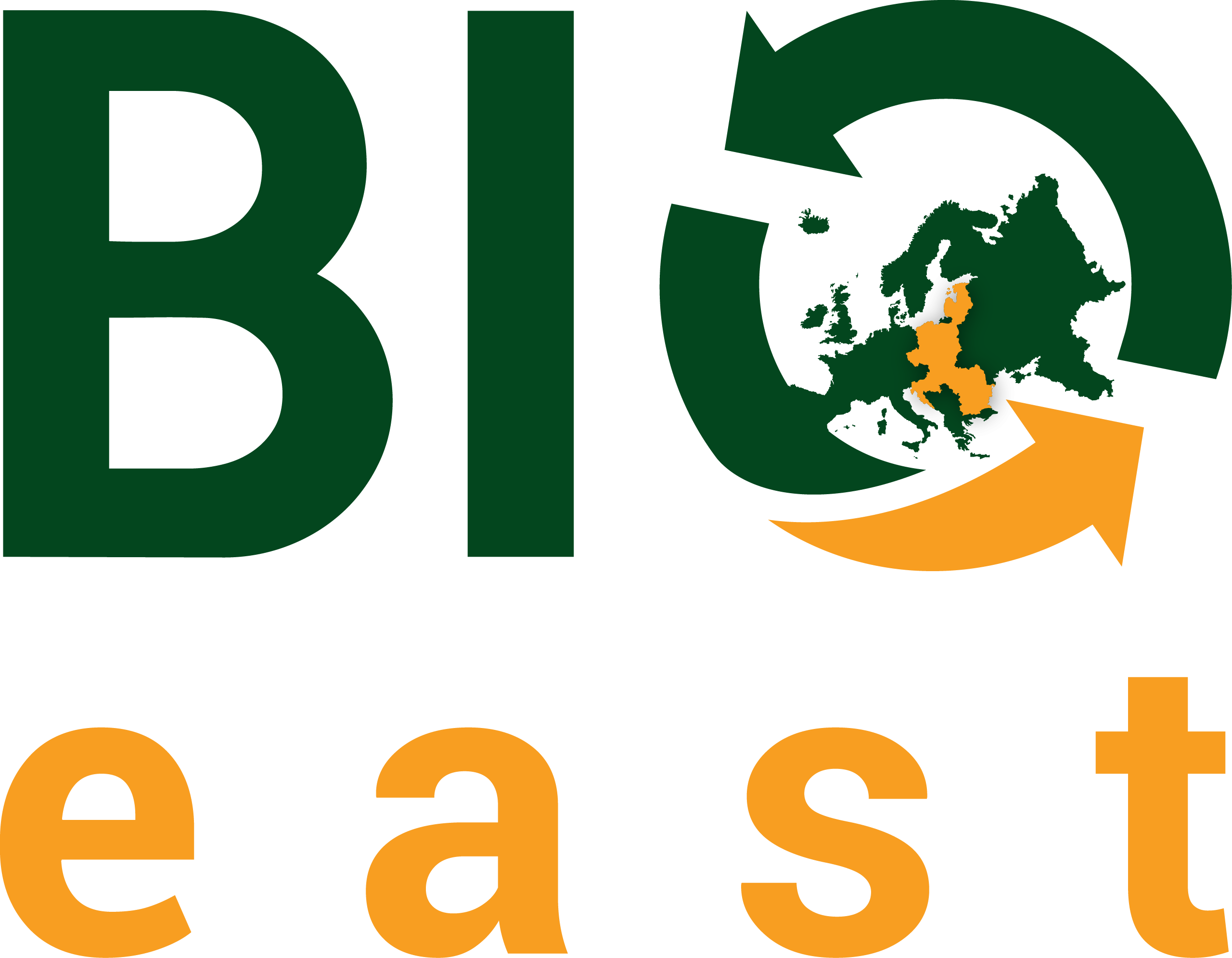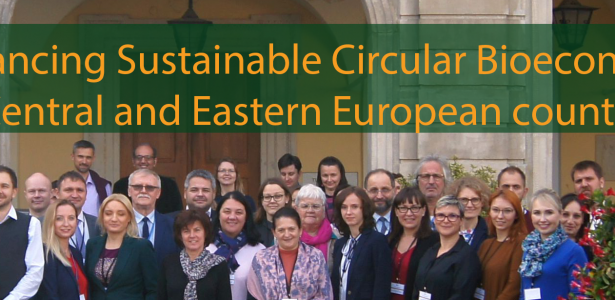D1.2. REPORT ON ANALYSIS OF BIOEAST NATIONAL BIOECONOMY RELATED SECTORS
The Report on the BIOEAST National Bioeconomy related sectors analyses the current state of the bioeconomy and its related sectors in the BIOEAST countries. It is organised in two main sections: 1) indicators and statistical evidence for BIOEAST countries and 2) identification of bioeconomy strategy objectives and bioeconomy monitoring indicators. Strategic research and innovation action (SRIA) document or other supporting research development of the national bioeconomy framework in BIOEAST countries. The report itself creates a living document, based on the statistical evidence. It gives suggestions how to verify and support the options considered both in National bioeconomy action plans and in Strategic research and innovation action (SRIA) document, supporting research development of the national bioeconomy framework, all considered in synergy within the EU Green Deal and its policy areas. It robustly indicates the exposed sectors, acknowledges the fact that the level of sustainability and circularity of the existing bioeconomy is unknown and seeks for solutions beyond bioeconomy itself to enable concerted transition towards carbon neutral Europe in 2050. The report raised awareness on the necessity of a coherent approach and supported the activities related to the National Inter-ministerial groups and the National stakeholder groups.
The report will be available on the website in Sep 2021.
D1.3. CEE VIRTUAL TOOLBOX: DRAFT
The ‘DELIVERABLE 1.3 CEE Virtual Toolbox draft’ is a web tool meant to be used by BIOEAST countries in support of the development of their national bioeconomy strategies. It provides guidance on how to use existing analytical and policy tools to better understand the bioeconomy potentials (i.e. biomass availability, regional stakeholders, innovative value-chains). It gathers and describes already existing tools from relevant projects (e.g. Power4Bio, BE-Rural, BioEcon, etc.) which can support the CEE countries to develop their own national bioeconomy strategies on the basis of regional and local experiences. The tool integrates an existing system dynamic model (that is “white box” causal-descriptive modelling tool) that was originally created for Latvia, now being accommodated to simulate assessment in Poland. It allows to manage employment, financial and greenhouse gas emission data related to cultivation of crops, forests, and production of added value products from certain raw materials. It interconnects macro, meso and micro scale of bioeconomy. Main measures represented are turnover of bioeconomy, added value and employment, investments, GHG emissions and land use. In addition, location quotient, bioeconomy labour productivity and added value to turnover parameters also are shown as output. There are several changeable parameters available for modelling: added value products, product price, unit production costs, other costs, discount rate, specific investment in technology, organic land fraction, value chain selection (on/off) and subsidies.
Link to the toolbox: https://bioeast.eu/cee/
D1.4. BIOECONOMY INSTITUTIONAL PROFILES – COMPARATIVE ANALYSIS, BENCHMARKING AND POLICY RECOMMENDATIONS
The report presents the results of activities on comparative analysis and benchmarking. It provides a comprehensive view of the resource endowments and current performance of bioeconomy in BIOEAST countries, institutional settings and systems of policy delivery, affecting the scale, and the pace of its (current and future) development. Analysed data is benchmarked with EU countries, recognised as good bioeconomy performers (FI, NL, AT, DE). The desk study is complemented with the results of a web-based survey, in which bioeconomy experts and practitioners from BIOEAST macro-region assess (sector-specific) relevance of bioeconomy-related assets and transformation pathways. Results of the study are synthesised into policy recommendations and provide a basis for further work of the BIOEASTsUP project, most notably the development of the National Bioeconomy Strategies Concept Papers as well as the BIOEAST SRIA.
The report will be available on the website in Sep 2021.
D1.5. REPORT ON PREPARING THE NATIONAL PLATFORMS FOR BIOECONOMY STRATEGIES DEVELOPMENT
The 11 BIOEAST member countries have established national platforms aiming to facilitate the transformation to sustainable circular bioeconomy.These platforms consist of Bioeconomy InterMinisterial group (BAIMG) setting the priorities for the development of the bioeconomy in each country and National Stakeholder Groups (NSG) including experts from research, industry as well as practitioners and representatives of the general public. In total, more than 400 stakeholders are already engaged in the national platforms in the 11 BIOEAST countries activities regarding BioEastsUP project tasks analysis.
D1.6. CEE VIRTUAL TOOLBOX
BIOEASTSUP CEE virtual toolbox provides guidancehow to use existing analytical and policy tools tobetter understand the bioeconomy potentials (i.e.biomass availability, regional stakeholders, innovative value-chains). Furthermore, the toolbox demonstrates a tool: performing simulation assessment of the level of support for bioeconomy strategy development and the impact on the national economy in the BIOEAST countries. An existing system dynamic model (i.e. “white box” causal descriptive modelling tool) that has been created for Latvia will be used to simulate assessment in Poland.
D1.7. REPORT ON NATIONAL BIOECONOMY STRATEGIES CONCEPT PAPERS
The 11 BIOEAST member countries have preparedBioeconomy Concept Papers (BCP). These papers analyse the state of bioeconomy sectors in each country, the prevailing and alternative definitions of bioeconomy and potential transformation pathways. Further analysis was dedicated to selected most promising bioeconomy sectors that classify as traditional or niches of bioeconomy. Strategic directions and actions for the deployment of bioeconomy conclude the papers.
DELIVERABLE 1.7 REPORT ON NATIONAL BIOECONOMY STRATEGIES CONCEPT PAPERS.PDF
D2.2. REPORT ON THE IMPLEMENTATION OF THE WORKSHOPS
The objective of Task 2.2 was to coordinate and implement the capacity building knowledge exchange workshops. The aim of the knowledge exchange workshops was to reach out to the people who are building connections between the different stakeholders, such as researchers, industrial players, and rural facilitators in the field of bioeconomy. Furthermore, it planned to enhance the capacities of the selected stakeholders’ representatives to better understand the bioeconomy concept and bioeconomy business models and combine their skills and abilities and ensure general knowledge sharing and common level of knowledge on bioeconomy for the national stakeholders in BAIMG, NSGs, as well as from the BIOEAST TWGs. The target was to make the bioeconomy framework, for implementing multi-actor projects more achievable and available for the different stakeholders in the BIOEAST countries though improving their skills and abilities.
D2.3. TECHNOLOGY TRANSFER GOOD PRACTICE HANDBOOK
The main goal of this task is to provide advice how to manage and support transferring innovative ideas into new projects in the framework of bioeconomy. This report summarizes good practice and peers’ recommendation how to enhance collaboration of research organisations, stakeholders and practice on transfer and adoption of bioeconomy innovations in line with the AKIS concept.
D3.4 BIOEAST FORESIGHT EXERCISE REPORT
In line with the implementation of the BIOEAST Vision 2030, which was endorsed in February 2018, in the framework of the BIOEASTsUP project a macro-regional Foresight Exercise was conducted between April 2020 and May 2021 to support the BIOEAST member states in developing their sustainable bioeconomies. The task was to build on the ongoing European or global reports, to deliver new insight about possible changes of importance for the development of the macro-regional bioeconomies.
The aim is to give guidance to national policy makers, to identify special challenges the macro-region might face with the ultimate aim to contribute to the BIOEAST Strategic Research and Innovation Agenda.
A Foresight Expert Group (FEG) of five independent experts (https://bioeast.eu/foresight-expert/) was nominated to provide a better understanding about existing and new trends. Four areas were suggested by the policy makers: Sustainable natural resources, particularly soils and water, Sharing economy in the context of sustainable food system, Renewable carbon use and decarbonisation pathways, Governance in the context of circular and sustainable pathways.
The five experts lead the preparation of the Foresight Report in a participatory approach, engaging policy makers and external experts. Two rounds of national workshops within the BIOEAST countries engaging external stakeholders and multiple sectors were organized. Four internal restricted meetings between experts and BIOEAST ministries and invited experts were organized, including two scenario-building workshops in March and May 2021 to validate the scenarios defined in the Foresight Report. The workshops gathered stakeholders from four different backgrounds: government & public bodies, businesses, societies and NGOs and academics & research to design and characterize in a co-design manner the different points of view regarding the scenarios for the bioeconomy.
The report will be launched during an international conference planned for September 2021.
D3.5. ADVISORY COUNCIL MEETINGS REPORT
This deliverable presents involvement of the functional macro-regional structure that will provide long lasting support to the BIOEAST Initiative in the project activities in compliance with the project objectives and GA.
D3.7. REPORT ON FIVE STUDIES DROM THEMATIC WORKING GROUPS ON RESEARC AND INNOVATION NEEDS
Aim of this report is to provide a comprehensive overview of the process of preparing thematic studies, which were done with the support of WP3 and the technical assistance of T3.3.
D4.2. “REPORT ON THE STATE-OF-THE-ART INNOVATION GAPS AND NEEDS OF THE BIOECONOMY RELATED RESEARCH AND INNOVATION THE BIOEAST MACRO-REGION”
The report includes 11 country reports that for each country provides overview of economic and innovation profile and bioeconomy performance, bioeconomy related research and innovation profile, review of national research and innovation strategies and policy, as well as overall assessment of the bioeconomy related research innovation (SWOT analysis, innovation gaps and needs). The report provides also a summary of the main results for the whole BIOEAST macro region.
The report will be available on the website in Sep 2021.
D4.4 SRIA STAKEHOLDER
This report presents the main conclusions of the validation carried out with the “DELIVERABLE 4.3: BIOEAST SRIA”. They contain the assessments provided during the whole validation process and the sub-regional workshops in Ljubljana, Tartu and Warsaw. The validation was conducted with the use of a survey questionnaire and “Slido” application. The structure of the report and the study itself takes into account the guidelines presented in “DELIVERABLE 4.1: FRAMEWORK FOR THE SRIA DEVELOPMENT”. The report includes also a study on regional dimensions of the BIOEAST SRiA.
D4.5. THE BIOEAST SRIA
Final version of the BIOEAST SRIA document, Executive summary of the BIOEAST SRIA document.
D4.6. BIOECONOMY CONGRESS “STRATEGIC RESEARCH AND INNOVATION AGENDA FOR THE BIOEAST COUNTRIES”
The high level international BIOEAST Congress was organized in the framework of the BIOEAST Initiative and under the auspices of the Polish Ministry of Agriculture and Rural Development with the support of the Horizon 2020 BIOEASTsUP project.
D5.1. PROJECT WEBSITE
The BIOEASTsUP website is the key tool for broader dissemination. It is also a communication tool during the lifetime of the project and beyond. The site incorporates basic project information, key results, project structure, project outputs, participants and also contains news. The domain of the website is: https://bioeast.eu/bioeastsup . The web pages will also offer added-value services such as overview about the situation in the bioeconomy in BIOEAST countries, publications, newsletters, surveys and also the direct link to national web pages dedicated to bioeconomy (e.g. web pages of national BIO HUBs). The web pages were launched in December 2019 and will be maintained during the project implementation and at least two years after the BIOEASTsUP project conclusion.
D5.2: PROJECT E-NEWSLETTERS
D5.5. DYNAMIC WEB BASED SEARCHING ENGINE
Task 5.5 of the BIOEASTsUP project is responsible for the development of the method and the structure of the Stakeholders’ database. The ambition was to build a complete inventory of all relevant experts in the bioeconomy value chains that operate in the BIOEAST countries. The BIOEASTsUP project activities, particularly those involving various stakeholders external to the project, were suitable avenues to address and encourage them to participate in the stakeholders’ database. With its gradual growth, the inventory aims to become an authoritative source of exchange, and networking among the BIOEAST macro-region’s bioeconomy stakeholders such as policy makers, local, regional, national authorities, researchers, academia, local advisors, investors, biomass suppliers and, industries from different sectors along the value chain
D5.7. PROJECT E-NEWSLETTERStoggle-h3
This deliverable summarizes the last 3 newsletters that were produced in the second half of the of the BIOEASTsUP project.

